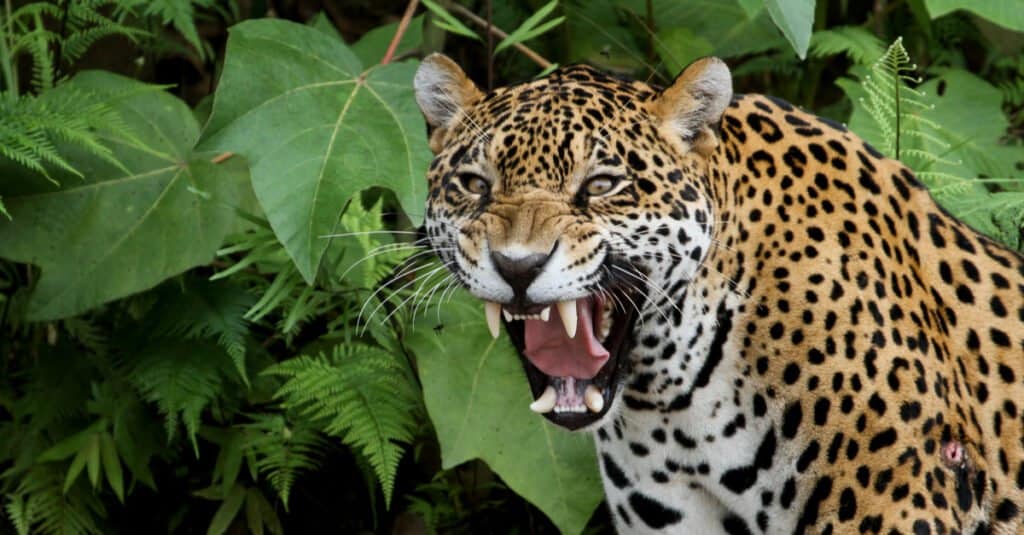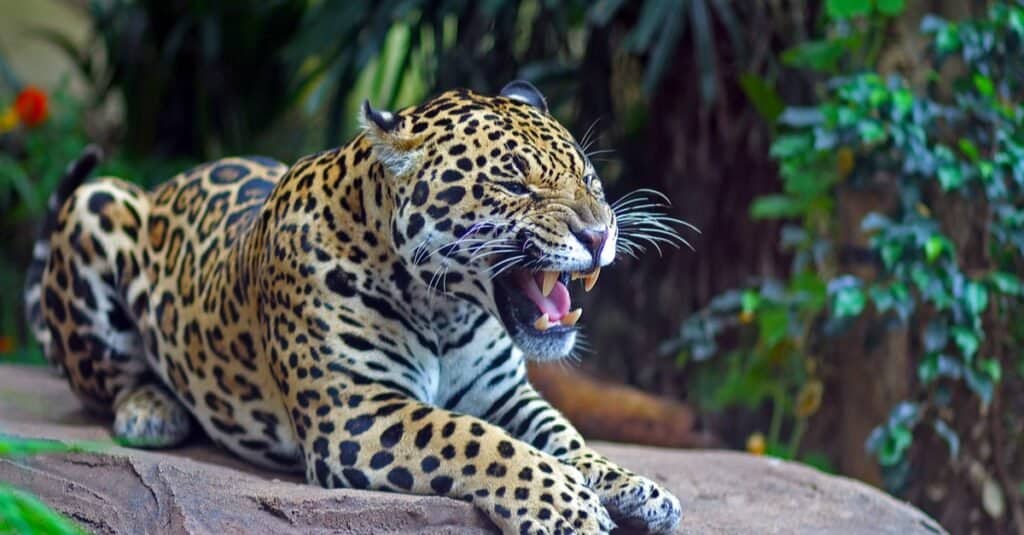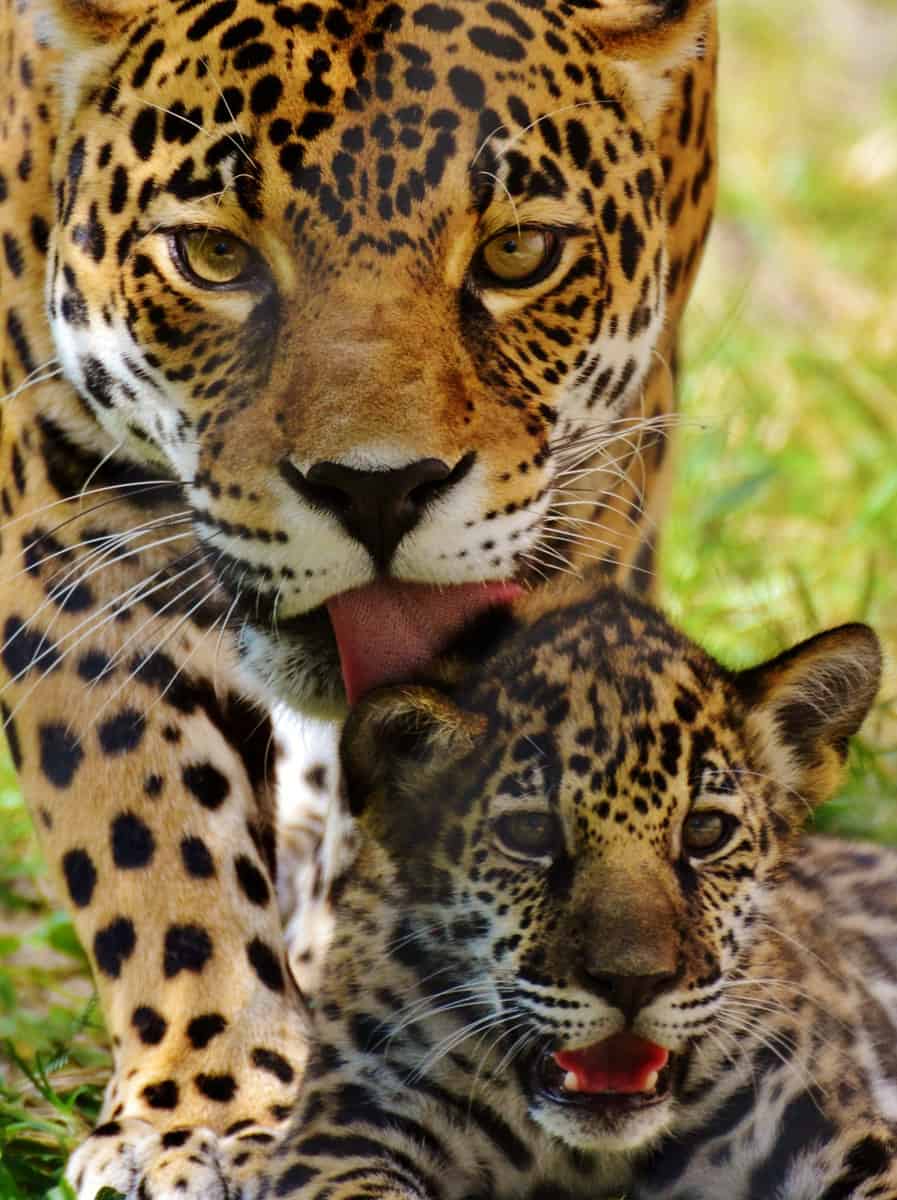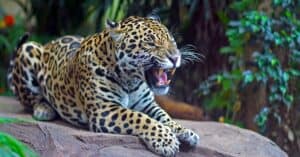Jaguars are the third largest of the large cats of the Panthera genus. They are known to grow even longer than six feet (1.85 m) and weigh up to 348 pounds (158 kg). Jaguars are even more unique because they are the last surviving large cats native to the Americas.
These felines have strong bodies, frames, and of course, teeth. Like most wild animals, their teeth are an important part of their lives and survival. Jaguars are even more exciting because, like most big cats, they have canine teeth, popularly known as fangs.
The Structure of a Jaguar’s Teeth

Jaguars have 30 teeth.
©Adalbert Dragon/Shutterstock.com
Jaguars have incisors, molars, premolars, and of course, canine teeth or fangs. On their upper jaws, they have six incisors (three on each side), two canines (one on each side), two molars (one on each side), and six premolars (three on each side).
On the lower jaws, they have six incisors (three on each side), two canines (one on each side), two molars (one on each side), and four premolars (two on each side).
The major difference between their upper and lower jaws is that their upper jaws have two more premolars (one on each side) than their lower jaws. In total, jaguars have 30 teeth.
What Do Jaguars Use Their Teeth For?

Jaguars’ teeth help them in battling prey.
©GoWildPhotography/Shutterstock.com
Like most animals, jaguars use their teeth to battle prey, defend themselves, bite, and eat. However, each section of their teeth has a different use. Jaguars use their incisors to efficiently rip or tear flesh into pieces. Their molars, which use a lot of jaw power, are used to grind and crush, while premolars grind, crush, and slice. They are also rather similar to saws in shape and sharpness.
What Do Jaguars Use Their Canine Tooth For?
Jaguars use their canine teeth or fangs the same way all big cats do; to tear into flesh. Canine teeth are the longest teeth found on big cats. Although there are no public studies on the lengths of jaguars’ fangs, we know that lions’ measure about four inches while tigers’ measure about three. Jaguar canines are, however, large, thick, and shaped like cones.
What Is a Jaguar’s Bite Force?

Jaguars have a bite force of 1,500 pounds per square inch.
©mjf795/ via Getty Images
Jaguars have a terrifying bite force of about 1,500 pounds per square inch, and it is worth noting that no other big cat has such a heavy bite. Lions, for example, have a bite force of about 650 pounds per square inch, while tigers’ bite force is ranked at 1,050 pounds per square inch.
With such a heavy bite force, they successfully prey on large animals such as deer, alligators, and even tortoises. Their incredible force allows them to crack the skulls of their victims with a single bite.
Jaguar Jaws
As expected, jaguars have really strong jaw muscles due to their placement and arrangement. Their jaw placement provides more space for muscles, making them stronger than other big cats’. However, despite this, their jaws are rather short in proportion to their weight, giving them extra grip and strength.
Jaguars also have larger skulls than leopards, allowing them to open their mouths wider than any other big cat. It is also why they kill their prey quite differently from other big cats. While other big cats go for the neck or spines of their victims, jaguars go for their skulls. They can attack prey three to four times as heavy as they are.
Baby Jaguar Teeth
Like human babies, baby jaguars aren’t born with teeth. According to the San Diego Zoo, their teeth appear when they are about one month old. However, they continue to feed from their mother until they are about six months old. Even then, baby jaguars do not leave their mothers until they are about two years old.
Despite how sharp and deadly jaguars’ claws are, mother jaguars often use their teeth to gently carry or move their cubs with them without any scratches.
Like all big cats, baby jaguars first develop milk or deciduous teeth, which fall out later on and give way to adult teeth.
How Do Jaguars Use Their Teeth To Hunt?
When jaguars hunt, they do not use only their teeth; their razor-sharp claws and hunting abilities also come into play. Jaguars are excellent hunters that stealthily stalk their prey. They ambush their prey and usually kill them with a single bite to the skull, but may also use other tactics. Although jaguars are fast and can run at speeds of up to 50 miles per hour for short distances, they seldom do.
They prefer to ambush their prey with the element of surprise on their side. Jaguars’ teeth are strong enough to pierce through thick animal hide, and their tongues have papillae that allow them to lick flesh and fur right off the animal’s bones.
Do Jaguars Teeth Grow Back When Lost?
Jaguars’ teeth are extremely strong, so it takes quite a lot to damage one- much less pull it out. However, if this happens, the tooth will not grow back. Often, jaguars develop dental problems, but modern medicine enables doctors to treat many cases effectively.
Jaguar Canine Tooth or Fang Smuggling
Considering that jaguars are the only big cats left in the Americas, it comes as no surprise that they are an endangered species. Apart from habitat loss, one major cause of this is traditional Chinese medicine.
Since traditional Chinese medicine believes that jaguar fangs have medicinal benefits, they are highly sought after.
This leads to people hunting jaguars for their canine teeth and smuggling them out of the country. Of course, this is illegal, and caught smugglers face jail time.
Do Jaguars Bite Humans?
Although not common, jaguars do attack humans. Most of these attacks occur in circuses and places where these animals are kept as exotic pets. Jaguars aren’t typically aggressive, but when hunting or defending themselves, they are unforgiving beasts with a one-track mind. This is why most jaguar attacks on humans are fatal.
A 2011 study states that jaguar attacks are on the rise from previous centuries in places such as Central Brazil, and one of the major causes of this is modernization. Jaguars do not attack humans for fun but because they are forced to hunt outside their habitats.
Up Next:
Discover The Largest Jaguar Ever
Leopard vs. Jaguar – The 7 Key Differences
The photo featured at the top of this post is © iStock.com/Patryk_Kosmider
Sources
- WCS, Available here: https://www.wcs.org/our-work/species/jaguars
- Reid Park Zoo, Available here: https://reidparkzoo.org/blog/jaguar-jaw-muscles
- San Diego Wildlife Explorers, Available here: https://sdzwildlifeexplorers.org/animals/jaguar
Thank you for reading! Have some feedback for us? Contact the AZ Animals editorial team.






